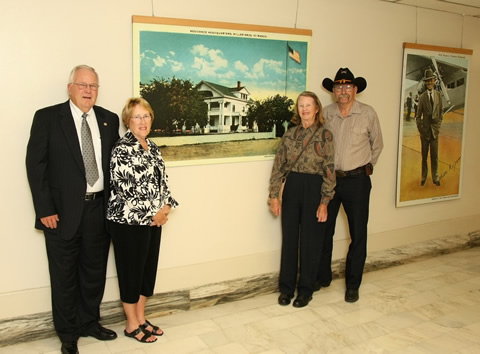Senator Myers Honors 101 Ranch Old Timers
 Sen. David and Sara Myers pose alongside the State Capitol print they sponsored of the majestic 101 Ranch residence headquarters, the Miller Mansion, with the 101 Ranch OTA President Jean Evans and Sec/Treasurer Joe Glaser.
Sen. David and Sara Myers pose alongside the State Capitol print they sponsored of the majestic 101 Ranch residence headquarters, the Miller Mansion, with the 101 Ranch OTA President Jean Evans and Sec/Treasurer Joe Glaser.
 Sen. Myers presents the 101 Ranch OTA on the Senate Floor with a large panoramic picture of the ranch to be displayed at the 101 Ranch Old Timers Museum in Ponca City.
Sen. Myers presents the 101 Ranch OTA on the Senate Floor with a large panoramic picture of the ranch to be displayed at the 101 Ranch Old Timers Museum in Ponca City.
Members of the 101 Ranch Old Timers Association visited the State Capitol recently to see a print of the ranch's majestic residence headquarters, the Miller Mansion. The print, sponsored by Sen. David and Sara Myers, hangs in the lower level of the Capitol along with several other historical pictures including a print of Will Rogers. During their visit, Sen. Myers also presented the members with a large panoramic picture of the ranch to be displayed at the 101 Ranch Old Timers Museum in Ponca City.
"I was so proud to sponsor the 101 Ranch Old Timers project at the Capitol. The ranch played an important role not only in Kay County, but the entire state," said Myers, R-Ponca City. "The era of cowboys and cattle ranchers was such a colorful part of our state's history, and I applaud the members of the Old Timers Association for keeping that history alive."
The Capitol print features the once majestic Miller family mansion, known as the White House, which was constructed in 1909. It featured 17 spacious rooms and every modern convenience available, and was one of Oklahoma's first ‘Palaces on the Prairie’. Unfortunately, it was demolished for salvage value by order of the Federal Farm Security Administration in 1943 due to a long term federal bankruptcy proceeding.
“Senator Myers has been very supportive of our history preservation efforts and a good friend of our organization. He has a great appreciation of the unique western history of north central Oklahoma and the Ponca City area particularly,” said 101 Ranch O.T.A. Vice President Al Ritter. “When he asked us to help with an image for the Friends of the Capitol Project, we were happy to help out. The 101 Ranch White House and the other images found in the print make a great historical display representative of different geographical areas of the state.”
The nonprofit 101 Ranch Old Timers Association was organized in 1968 as a revival of the Cherokee Strip Cow Punchers Association, which was created by Colonel Joe C. Miller in 1920. Membership in that first organization was limited to working cowboys and others associated with the cattle industry in the Cherokee Strip during the time period from 1874 to 1893.
The Association has fought to preserve the history of the ranch through the collection and preservation of articles and artifacts - many of which are on display at their museum located in the lower level of Marland’s Grand Home in Ponca City. The organization owns all that remains of the 101 Ranch located five miles southwest of Ponca City on State Highway 156. The site is operated and maintained as a roadside park, which is open during daylight hours. In the last two years, three illustrated podium style information signs have been added to the site and more historical signs are being planned.
Thanks to the efforts of the Association, the 101 Ranch Headquarters, located on the north bank of the Salt Fork River, southwest of Ponca City in Kay County Oklahoma, was placed on the National Register of Historic Places in 1973. In 1975, the site was designated as a National Historic Landmark.
Ritter pointed out that membership in the organization is open to anyone interested in helping preserve the memory of the once majestic 101 Ranch of Oklahoma.
 Oklahoma Senate
Oklahoma Senate

